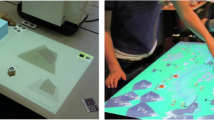Abstract
This chapter is an introduction to object-based learning, the application of object-based learning in university classrooms, and the complimentary use of objects as concrete referents for abstract concepts. Objects are physical, three-dimensional entities created by humans, and object-based learning is a student-centered approach to using objects to facilitate learning. Slow looking is introduced as the core activity of object-based learning as slow learning allows students to build context, or “disambiguate” the object. Once disambiguated, the object can then become a concrete referent. Lastly, three examples of this process are shown to develop a list of characteristics that best support student participation in object-based learning.
Access this chapter
Tax calculation will be finalised at checkout
Purchases are for personal use only
Similar content being viewed by others
Notes
- 1.
Some scholars use the term object-centered learning (Paris, 2002). The terms are interchangeable.
- 2.
This exercise is a methodology developed by Dr. Mary Alice Casto for her 2015 doctoral dissertation Categories of Design for Sustainability: A Wearer’s Perspective of Classic Design.
References
Adams, K. M. (2015). Back to the future?: Emergent visions for Object-Based Teaching in and beyond the classroom. Museum Anthropology, 38(2), 88–95.
Berger, A. A. (2014). What objects mean: An introduction to material culture. Routledge.
Casto, M. A. (2015). Categories of design for sustainability: A wearer’s perspective of classic design. University of Minnesota Press.
Chatterjee, H. J. (2010). Object-based learning in higher education: The pedagogical power of museums. In Proceedings of the 9th conference of the International Committee of ICOM for University Museums and Collections (UMAC), Berkeley, USA, 10th–13th September 2009 (pp. 179–182). International Committee for University Museums and Collections. Retrieved from https://edoc.hu-berlin.de/handle/18452/9349?show=full
Chatterjee, H. J. (2007). Staying essential: Articulating the value of object-based learning. University Museums and Collections Journal.
Fini, C., & Borghi, A. M. (2019). Sociality to reach objects and to catch meaning. Frontiers in Psychology, 10, Article 838. Retrieved from https://www.ncbi.nlm.nih.gov/pmc/articles/PMC6491622/pdf/fpsyg-10-00838.pdf
Miller, D. (2010). Stuff. Polity Press.
Paris, S. G. (2002). Perspectives on object-centered learning in museums.: Routledge.
Prown, J. D. (1982). Mind in matter: An introduction to material culture theory and method. Winterthur Portfolio, 17(1), 1–19.
Prown, J. D., & Haltman, K. E. (2000). American artifacts: Essays in material culture. Michigan State University.
Riello, G. (2018). Things that shape history: Material culture and historical narratives. In K. Harvey (Ed.), History and material culture: A student’s guide to approaching alternative sources (2nd ed., pp. 27–50). Routledge.
Roberts, J. (2013). The power of patience: Teaching students the value of deceleration and immersive attention. In The Harvard initiative for learning and teaching. Harvard Magazine. Retrieved from https://harvardmagazine.com/2013/11/the-power-of-patience
Rose, S. (2017). Close looking and conviction. Art History2, 40(1), 156–177.
SIL Glossary of Linguistic Terms. (n.d.). Retrieved September 8, 2020, from https://glossary.sil.org/
Tishman, S. (2017). Slow looking: The art and practice of learning through observation. Routledge.
Wiley, D. A. (2002). Connecting learning objects to instructional design theory: A definition, a metaphor, and a taxonomy. In D. A. Wiley (Ed.), The instructional use of learning objects (pp. 1–24). Agency for Instructional Technology; Association for Educational Communications & Technology. Retrieved from https://members.aect.org/publications/InstructionalUseofLearningObjects.pdf
Williams, P. (1982). Object-oriented learning in art museums. Retrieved from https://sjmusart.org/sites/default/files/files/object-oriented-learning-in-art-museums.pdf
Acknowledgments
The examples in this article were conducted, while the author was the Dora Wallace Collections Assistant at the Goldstein Museum of Design (GMD) at the University of Minnesota and as a teaching assistant in the College of Design at the University of Minnesota. The author wishes to thank GMD for their support of these experiences, especially Lin Nelson-Mayson, Jean McElvain, and Eunice Haugen, and the support of University of Minnesota lecturer Pat Hemmis.
Author information
Authors and Affiliations
Corresponding author
Editor information
Editors and Affiliations
Rights and permissions
Copyright information
© 2021 Association for Educational Communications and Technology (AECT)
About this chapter
Cite this chapter
Oberg, C.S. (2021). When a Pen Is More than a Pen: Object-Based Learning and the Value of Objects as Concrete Referents. In: Hokanson, B., Exter, M., Grincewicz, A., Schmidt, M., Tawfik, A.A. (eds) Learning: Design, Engagement and Definition. Educational Communications and Technology: Issues and Innovations. Springer, Cham. https://doi.org/10.1007/978-3-030-85078-4_19
Download citation
DOI: https://doi.org/10.1007/978-3-030-85078-4_19
Published:
Publisher Name: Springer, Cham
Print ISBN: 978-3-030-85077-7
Online ISBN: 978-3-030-85078-4
eBook Packages: EducationEducation (R0)




